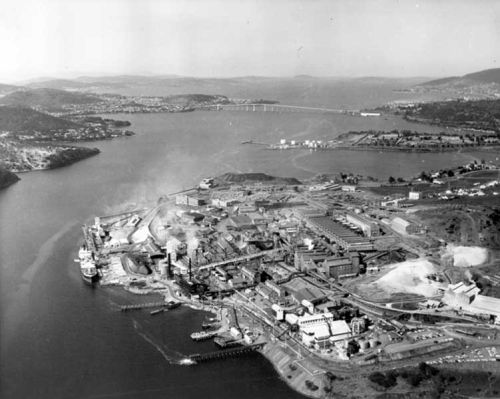 |
 |
|
Electrolytic Zinc Works
The Electrolytic Zinc Works were established by the Electrolytic Zinc Company at Risdon beside the Derwent in 1916, due to a number of circumstances: the First World War disrupted the supply from Germany of zinc, vital for munitions; the electrolytic method had been developed to produce zinc cheaply; and the huge amounts of electricity necessary were available through Tasmania's new hydro-electric scheme. Zinc ore came from Broken Hill and Rosebery. Under Herbert Gepp as manager, production started in 1918. Zinc concentrate arrived at the wharf, was roasted to remove sulphur, then dissolved in sulphuric acid. An electric current passed through the solution and zinc was deposited on cathodes. 'Strippers' stripped off the zinc, which was cast into slabs. Byproducts included superphosphate, cadmium and some other metals. In the 1920s the plant developed, with 1300 employees. Work was often hard due to dust, sulphur fumes, hours of shift work (the plant ran 24 hours a day) and the nature of the work, often manual labour with pick and shovel, but the Company provided amenities such as hot showers and, more importantly, security, a Christmas bonus, a training programme with priority for zincworkers' children, and opportunities for promotion, which mostly came from within. This was appreciated: the Zinc Works brought modest prosperity to many who had never known permanent employment, and they became a loyal workforce. Gepp ran a paternal plant but invited employee input, with a Co-operative Council (1918–c 1994) containing representatives of employees and management providing cheap goods, accommodation at the 'company village' of Lutana, assistance in buying homes, a health service, and sports and picnics for employees. Less successful was a Works Committee (1918–48), intended to take the place of a trade union, which it did for a time. The price of zinc crashed in the Depression. Wages were cut and many employees sacked, but production did not fall, and conditions improved from 1935. By now the Company, a benign employer at first, provided barely average wages and hours, and 1936 saw the formation of the Zinc Workers' Union, which won a 40-hour week and other improvements, but was not militant. The Zinc Works was a protected industry during the Second World War, and the 1950s and 1960s were prosperous, with high zinc prices, excellent bonuses, a huge construction programme (Risdon became the world's second largest zinc plant), improved working conditions, and a peak of 2800 employees in 1967. From 1965, zinc was recovered from previously intractable waste through the jarosite process. But the 1970s brought low zinc prices, higher wages, retrenchments, the disappearance of many jobs with automation, more militant unions and industrial strife. Pollution became an issue: since 1918, waste had gone into the Derwent but criticism had been minimal. In the 1970s the Derwent was found to be polluted and the Zinc Works was blamed, amid much publicity. Eventually, the Company controlled pollution. In 1984 North Broken Hill took over the Company and modernised the run-down plant. In 1988 North's mining interests became part of Pasminco, one of the world's largest base metal companies. Since then the plant has seen ups and downs with fluctuating zinc prices and more industrial strife, especially as automation meant even fewer employees, but the situation settled. In 2003 the Zinc Works employed 557 permanent staff. Pasminco appointed administrators in 2001, and in 2004 many of its assets, including the Risdon plant, were taken over by a new firm, Zinifex. Further reading: A Alexander, The Zinc Works, Hobart, 1992. Alison Alexander |
Copyright 2006, Centre for Tasmanian Historical Studies |
